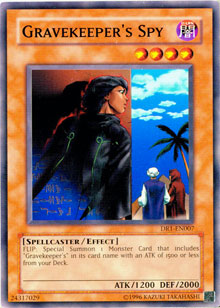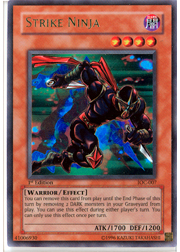While considering different decks for my New Grounds column, I had a few problems relating certain strategies to individual themes. As we all know, the word “theme” can have a variety of meanings. It can refer to the deck’s pivotal cards, its primary method of achieving victory, or the subtypes (or even attributes) of the monsters in the deck. I thought it would be interesting to discuss the notion of themes, and how they correspond to the different original decks that I build and playtest. In addition, to make future New Grounds columns easier to understand, I want to introduce a new term: “concept deck.” To explain how I came across this term, and why I will be using it in my New Grounds columns, we must first revisit the idea of a themed deck.
Themes: Building a Better Tomorrow Through Unity
Examples of top-tier themed decks are everywhere. A great example is the standard Gravekeeper deck. Utilizing monsters like Gravekeeper’s Spy and Gravekeeper’s Assailant, we can organize the Gravekeeper theme like so: we name the theme, determine its general synergies and goals, then pick the pivotal cards of the theme (the specific cards used to achieve the goals).
Build: Gravekeepers
General Synergies and Goals:
1) Swarm through Rite of Spirit, Gravekeeper’s Chief, and Gravekeeper’s Spy.
2) Pre-negate opponent’s graveyard-related cards to generate card advantage (like Magician of Faith, Premature Burial, and Call of the Haunted).
Pivotal Cards:
1) Gravekeeper’s Spy
2) Necrovalley
 Having established the pivotal cards behind the Gravekeeper deck, the savvy player will then work on supporting these conditions with cards that counterbalance their weaknesses. For example, an array of cards that can support Gravekeeper’s Spy are Spell Shield Type-8, My Body as a Shield, Confiscation, and Magic Drain (which incidentally helps out both Spy and Necrovalley). If Gravekeeper’s Spy gets crossed out, you can expect your win percentage to dip drastically. Therefore, establishing the win condition and then working to both protect and achieve it are two essential keys to success.
Having established the pivotal cards behind the Gravekeeper deck, the savvy player will then work on supporting these conditions with cards that counterbalance their weaknesses. For example, an array of cards that can support Gravekeeper’s Spy are Spell Shield Type-8, My Body as a Shield, Confiscation, and Magic Drain (which incidentally helps out both Spy and Necrovalley). If Gravekeeper’s Spy gets crossed out, you can expect your win percentage to dip drastically. Therefore, establishing the win condition and then working to both protect and achieve it are two essential keys to success.
Let’s take a look at another theme.
Build: Dark Scorpions
General Synergies and Goals:
1) Generate card advantage through Meanae the Thorn in a closed-resource game, where there are very few resources for each player. This will force your opponent to topdeck against all of your different threats on the field.
2) Swarm the opponent while cutting his or her options off one-by-one.
Pivotal Cards:
1) Dark Scorpion – Meanae the Thorn
You can take a look at my initial build of this deck here. It packs three copies of Smashing Ground, two Nobleman of Extermination, and various other 1-for-1 trades. Basically, every single card in that deck invites either a 1-for-1 trade or greater! The goal is to use rapid tempo and expenditure of cards in the hand and on the field to give Meanae the opportunity to build additional forces. Then, you’ll start summoning one-by-one while destroying the opponent’s field. This theme takes a few strengths from perhaps the best themed deck in existence.
Build: Warrior Toolbox
General Synergies and Goals:
1) Utilize and take advantage of a rapid tempo.
2) Use the advantages of the closed-resource game to find the best monster for any situation through Reinforcement of the Army.
Pivotal Cards:
1) Reinforcement of the Army
The versatility of Reinforcement of the Army makes this deck work. If you see a face-down monster, dig out Mystic Swordsman LV2. If you see a D. D. monster, grab D.D. Survivor! If you need a Light monster for Chaos Sorcerer, dig out that D. D. Warrior Lady or Blade Knight.
At this point, I’ve provided three solid examples of themed decks that fit my criteria. First, they are composed of monsters that have similar subtypes. Second, they have spell or trap support that helps augment the theme.
Take a look at these first decks I’ve built on The Juncture and New Grounds. They’re all basically themed decks! There are themed groups of subtype monsters put together with spells and traps that subtly augment their pivotal cards. At this point, I want to introduce the idea of the “concept deck,” since I’ll be working on these in the near future.
How to Conceptualize a Concept Deck
Concept decks do not fit the criteria that govern the idea of the themed deck. Rather than base their synergies on subtype, type, attribute, or even spell and trap support, concept decks are based on general overriding goals that might involve game mechanics, a single powerful card or strategy, or more obscure ideas like tempo, card advantage, and life points. For example, you might create an offensive burn deck that aims to use monster strategies that lower your opponent’s life points, while foregoing the use of stall-based strategies that often accompany burn decks. Let’s take a look at an example.
Build: Offensive Burn
General Synergies and Goals:
1) Lower opponent’s life points through effect damage.
2) Utilize viable methods of dealing lots of damage in a single turn.
Pivotal Cards
1) . . .
Therein lies the problem. This is a concept deck: the monsters, spells, and traps in the deck are supposed to work together to broaden the concept of offensive burn. Therefore, there are no specific cards that lead to this condition. Rather, the pivotal cards include an assortment of effective strategies we can use to achieve the goal. Let’s take a look at a sample decklist.
Monsters: 21
2 Cyber Dragon
2 Reflect Bounder
1 Airknight Parshath
2 Magician of Faith
1 Magical Merchant
2 Chaos Sorcerer
1 Sangan
1 Breaker the Magical Warrior
2 Mask of Darkness
1 Tsukuyomi
2 Mystic Tomato
2 Stealth Bird
2 Spirit Reaper
Spells: 13
3 Wave-Motion Cannon
2 Nobleman of Crossout
1 Heavy Storm
1 Mystical Space Typhoon
1 Confiscation
1 Graceful Charity
1 Snatch Steal
1 Premature Burial
1 Book of Moon
1 Swords of Revealing Light
Traps: 6
1 Ceasefire
1 Magic Cylinder
1 Mirror Force
2 Solemn Judgment
1 Call of the Haunted
No single card in this deck stands out as fundamental to the strategy. However, you can see that a few of the monsters either augment the slow and steady burn, or do it through effects. Two copies of Reflect Bounder add up to 1700 damage each over the course of the duel, Mask of Darkness cycles Ceasefire and Solemn Judgment, and Stealth Bird can push through 1000 damage each turn.
Wave-Motion Cannon, supported by Solemn Judgment, will simply end games if it’s played correctly at the right time. The combination of all these effects that deal burn damage, in addition to the beatdown capabilities of the original deck, make the offensive burn concept quite strong.
Let’s take another look at another concept deck that doesn’t entirely fit into a cohesive theme.
Build: Strike Ninja
General Synergies and Goals:
1) Cycle Strike Ninja’s ability with D. D. Scout Plane to create floaters on the board. These floaters are then sacrificed or used as bodies for various effects.
2) Create a low-resource game to make destroying Ninja next to impossible.
Pivotal Cards:
1) Strike Ninja
2) D. D. Scout Planes in the graveyard for minimal cost.
 In this case, the pivotal cards are quite simple. You want at least one Plane in the graveyard, a Strike Ninja in hand, and a tribute monster of some sort in your hand. Of course, this strategy requires a shift in gears. Initially, you simply want to maintain a slow tempo while building resources and sending planes to the graveyard. Later on, however, through rapid simplification of the board, you turn Ninja into an indestructible engine of destruction and can even push through 1600 damage per turn with the Planes.
In this case, the pivotal cards are quite simple. You want at least one Plane in the graveyard, a Strike Ninja in hand, and a tribute monster of some sort in your hand. Of course, this strategy requires a shift in gears. Initially, you simply want to maintain a slow tempo while building resources and sending planes to the graveyard. Later on, however, through rapid simplification of the board, you turn Ninja into an indestructible engine of destruction and can even push through 1600 damage per turn with the Planes.
However, note that none of the parts form a “themed” unit. Certainly, most of the monsters will be of the Dark attribute, but that’s about all that unites the different pieces. You’ll want a nice mixture of tribute monsters, which will include Light types like Zaborg the Thunder Monarch, Aqua types like Mobius the Frost Monarch, and even a Wind monster like B.E.S. Tetran! Meanwhile, you’ll also use different types of monsters to achieve different objectives—try out cards like Morphing Jar, which seems to go against the theme of Dark monsters, and Thunder Dragon, which will create synergy with the Planes.
The spell or trap lineup has a few goals, but you should mainly focus on using cards to dump Planes into the graveyard or take advantage of their status on the field as a floater. Card Destruction, Monster Reincarnation, and other such options will help the former goal, while cards like Enemy Controller and Creature Swap will take care of the latter. Again with the Strike Ninja build, we have to establish the goals of the deck, which aren’t necessarily part of a themed deck. Instead, it follows a few rigid concepts that help dictate proper card choices.
Other examples of conceptual decks help flesh out the idea. Imagine a deck using three copies of Peten the Dark Clown, Twin-Headed Behemoth, Cyber Dragon, Zaborg the Thunder Monarch, Chaos Sorcerer, and others, in an attempt to pack as many special summons and monster destruction effects to gain tempo. Such a deck is a great example of a concept deck.
A “New” New Grounds Approach
I came across the idea of the concept deck while browsing numerous submissions from different readers. I realized that while a lot of decks followed a distinct theme, others followed concepts that weren’t so easy to pin down. From this point on, each deck profiled on New Grounds will take even more exhaustive detail to list its origin and inspiration.
Previously, each deck would list Mechanics of Advantage, which was a vague way of referring to the deck’s pivotal cards. From this point on, each deck will list its initial goals and design, and then expand to include its theme or concept. I’ll make clear why certain spells or traps are tested, why certain monsters are selected, and which win conditions we should focus on when building the deck. With that said, I’m looking forward to a new round of deckbuilding with all of you.